Cost of wallpapering a ceiling in 2024
Article Updated 1st Oct 2024

Cost of Wallpapering a Ceiling in 2024: What to Expect
Wallpapering a ceiling can add a unique touch to any room, but it's not an easy job. In 2024, the average cost of wallpapering a ceiling in the UK can range from £300 to £700, depending on several factors. This article will delve into the steps involved in wallpapering a ceiling, how the size and scope of the job affect the price, the options available for materials, and how styles have evolved over the years.
The Steps Involved in Wallpapering a Ceiling
Wallpapering a ceiling is a meticulous task that involves several key steps. First, the ceiling must be thoroughly cleaned and primed. This ensures that the wallpaper adheres properly. Cleaning and priming can take around 2 to 3 hours and typically cost between £50 to £100.
Next, the wallpaper must be measured and cut to fit the dimensions of the ceiling. This step requires precision and can take an additional 2 hours, costing approximately £50 to £75. Following this, the wallpaper paste is applied, which can take another hour and cost around £30 for materials.
The most critical step is the application of the wallpaper itself. This can take anywhere from 3 to 6 hours, depending on the room size, and usually costs between £150 to £300 for labour. Finally, any excess wallpaper is trimmed, and the edges are sealed, taking an additional hour and costing around £20. To ensure the job has been well done, inspect for any air bubbles, misaligned patterns, or peeling edges.
How Room Size and Scope Influence the Price
The size and scope of the job significantly influence the overall cost. For example, wallpapering a small bathroom ceiling (around 5 square meters) will cost less than wallpapering a larger living room ceiling (15 square meters). In general, the larger the room, the higher the cost due to increased material and labour requirements.
Options often included in the job are pattern matching, which can add to the complexity and cost, and the use of specialised wallpaper such as textured or metallic finishes. Here is a quick list of options and their additional costs:
- Pattern matching: £50 to £100
- Textured wallpaper: £20 to £50 extra per roll
- Metallic finishes: £30 to £60 extra per roll
Material Choices and Evolving Styles
The choice of materials significantly impacts the total cost of the job. Standard wallpaper costs between £5 to £20 per roll, while premium options like textured or metallic wallpaper can range from £30 to £100 per roll. Additionally, eco-friendly wallpaper options are becoming more popular and can cost around £25 to £50 per roll.
In terms of style trends, bold patterns and textured finishes have gained popularity over the past few years. Floral and geometric designs are particularly trendy, as well as wallpapers that mimic natural materials like wood or marble. Over the last five years, the cost of both materials and labour has seen a gradual increase of about 10% to 15%, driven by inflation and the rising cost of raw materials.
In conclusion, wallpapering a ceiling in 2024 involves several steps, each contributing to the total cost. Room size, scope of the job, and material choices all play significant roles in determining the final price. As styles evolve, homeowners have a variety of options to choose from, each with its own cost implications. By understanding these factors, you can make an informed decision that adds both beauty and value to your home.